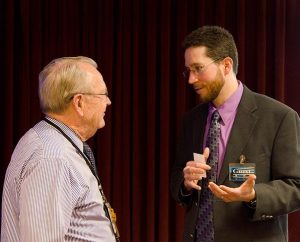By Roger Drinnon
ST. LOUIS — Factors behind the Synod’s overall numerical decline — down about 12 percent in the last decade alone — might not be what you think, in some cases.

The Synod’s Office of National Mission (ONM) hosted Dr. Ryan MacPherson, a professor at Bethany College, Mankato, Minn., and president of “Into Your Hands” consulting, Feb. 3 at the LCMS International Center here. MacPherson outlined some reasons for the Synod’s demographic decline while dispelling myths and offering recommendations for Synod leaders and laity attending his “Generational Generosity” summit.
MacPherson listed several “standard stories” — assumptions Missouri Synod Lutherans might hold to as either causes of or remedies for the decline. He debunked them all, based on his research. Some of these assumptions and MacPherson’s findings included:
- “If only we could evangelize more like the Baptists.”
MacPherson: The Southern Baptist Convention is also in decline and cannot boast of any higher evangelism gains above the LCMS.
- “LCMS is a rural Synod while America is increasingly urban.”
MacPherson: Rural, suburban and urban congregations all are experiencing a decline.
- “If only we weren’t so conservative, more people would come and more would stay.”
MacPherson: Facts show liberal church bodies have declined even faster than conservative ones.
Two major factors account for most of the downward trend in LCMS membership, according to MacPherson’s study. First, the birth rate has been declining for over 50 years for white-Anglo Americans of Northern European descent — a major Synod demographic. His study revealed that rising rates of divorce and non-marital cohabitation among younger people have exacerbated this challenge the Synod now faces.
Second, over the past 20 years, the retention rate of baptized infants as they grow up toward youth confirmation age also has declined.
“Only about half of the children baptized a decade-and-a-half ago were present for confirmation in the past few years,” noted MacPherson.
MacPherson said LCMS preschools and other such schools and childhood centers are commendable, but he cautioned that these are not a panacea for attracting young families.
His study showed that child baptisms plunged 55 percent from 1990 to 2010, a time frame when LCMS childhood centers were growing in number and enrollment.
“Although congregations with schools and elementary schools have tended to have a higher child-retention rate than congregations without schools, the retention advantage conferred by schools has been declining,” he said. “It seems that more and more families connect with a congregation for preschool, but then disengage in the years that follow.”
However, MacPherson emphasized that with half or more of LCMS preschool children being from outside the Synod, early-childhood centers present a significant mission opportunity, noting that programs focused on children often fail to engage the parents for the long term. He posited that more adult-to-adult ministry is needed as well as a holistic approach to young families.
“The family will be a key part of the LCMS’ future strength in sharing the Gospel,” said the Rev. Nathan Meador, assistant coordinator of stewardship for the ONM. “This report serves as a call to come to grips with who we have been, who we are now and then to seize the God-given opportunities to be who God called us to be. There is the idea that we are headed toward being a smaller church body in the future. It is accompanied by the reality that we hold a strong position as a ‘faithful remnant church’ going forward.”
Meador and the Rev. Heath Curtis, ONM stewardship coordinator, brought MacPherson to the International Center for the summit as part of the ONM’s stewardship-ministry efforts.
Roger Drinnon (roger.drinnon@lcms.org) is manager of Editorial Services for LCMS Communications.
Posted March 3, 2015
